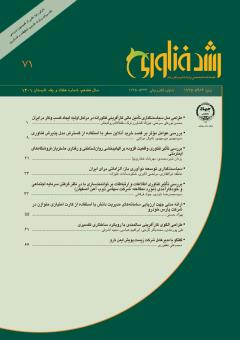طراحی مدل سیاستگذاری تأمین مالی کارآفرینی فناورانه در مراحل اولیه ایجاد کسبوکار در ایران
محورهای موضوعی : توسعه مدلهای کسب و کار در بنگاههای کوچک و متوسطمحسن نورعلی سرخنی 1 , عین اله کشاورز ترک 2 * , مقتداالانام روانبخش 3
1 - گروه مدیریت کارآفرینی؛ دانشگاه آزاد اسلامی واحد قزوین، قزوین، ایران.
2 - دانشگاه بین المللی امام خمینی، قزوین، ایران.
3 - عضو هیات علمی دانشکده مدیریت و حسابداری، دانشگاه آزاد اسلامی واحد قزوین، قزوین، ایران.
کلید واژه: سیاستگذاری, تأمین مالی, فناوری, کارآفرینی فناورانه , مراحل اولیه ایجاد کسبوکار,
چکیده مقاله :
روش پژوهش از نظر هدف کاربردی ، بر اساس نحوه گرد آوری داده ها توصیفی ، از نظر روش اجرا میدانی و از نظر ماهیت همبستگی است. پژوهش حاضر درصدد است با استفاده از رویکرد ترکیبی و با هدف اکتشافی از روش تحلیل نظریه زمینه ای دربخش کیفی به بازسازی معنایی ابعاد مختلف مدل / الگوی بهینه سیاست گذاری تامین مالی کارافرینی فناورانه درمراحل اولیه ایجاد کسب و کار بپردازد و با استفاده از نظرات مدیران ارشد و اساتید متخصص در این زمینه مفاهیم و تفاسیر موجود را از دیدگاه آنان بررسی کرده و در بخش کمی پرسشنامه ای با استفاده از مفاهیم اصلی مستخرج از بخش کیفی ساخته تا به تعمیم و تأیید یافته ها پرداخته شود. در این تحقیق ابتدا به منظور شناسایی روش های تامین مالی و هم چنین معیارهای انتخاب روش تامین مالی مناسب از روش دلفی فازی استفاده و سپس برای تعیین اولویت ها از تحلیل سلسله مراتبی استفاده و بعد از تعیین این اوزان از طریق روش تاپسیس به اولویت بندی گزینه های مطرح شده پرداخته شد. نتایج نشان داد از میان روش های تامین مالی تشکیل شرکت های تعاونی(0.93)، دریافت تسهیلات با وزن(0.87)، انتشار اوراق مشارکت با وزن(0.72)، ایجاد شرکتهای سرمایه گذار(0.60)، حضور در بازار بورس(0.33)، ایجاد طرح به صورت سهام دار(0.22)، و در نهایت جذب سرمایه خارجی(0.00001) به ترتیب بالاترین و پایین ترین اولویت را در بین روش های تامین مالی داشتهاند.
the present study seeks to semantically reconstruct the various dimensions of the model / optimal model of technological entrepreneurship financing policy in the early stages of business creation using the combined approach and the exploratory goal of the field theory analysis method in the qualitative section and using the opinions of senior managers. And the professors specializing in this field have examined the existing concepts and interpretations from their point of view and in the quantitative part a questionnaire has been made using the main concepts extracted from the qualitative part in order to generalize and confirm the findings. In this research, first in order to identify financing methods and also the criteria for selecting the appropriate financing method, fuzzy Delphi method is used and then to determine priorities, hierarchical analysis is used and after determining these weights through TOPSIS method to prioritize the option. The issues raised were addressed. The results showed that among the methods of financing the formation of cooperative companies (0.93), receiving facilities with weight (0.87), issuing participation bonds with weight (0.72), creating investment companies (0.60), presence in the stock market (0.33) ), Creating a plan as a shareholder (0.22), and finally attracting foreign capital (0.00001) had the highest and lowest priority among financing methods, respectively.
1- اردهالی، محمد, و هاشمپور، زینب (1388). مؤلفههای تعیینکننده کارآفرینی در اقتصاد ایران. فصلنامه برنامه ریزی و بودجه, 14(2), 39-59.#
2- نیکومرام, هاشم و حیدرزاده ، کامبیز. (1385). ارزیابی نقش گرایش کارآفرینانه، ساختار سازمانی و بازارگرایی بر عملکرد کسب و کار شرکت های تولیدی (شرکت های پذی رفته شده در بورس اوراق بهادار). مدیریت بازاریابی, 1(1), 1-50.#
3- صمیمی, مهدی, حسینی, سید حسن, اصغری, حرمت. (1397). عوامل مؤثر بر نوآوری فناورانه در واحدهای صنعتی دفاعی. مدیریت نوآوری در سازمان های دفاعی, 1(1), 118-140#
4- فاضلی ویسری، الهام، خرمی، آتنا. (۱۳۹۷). کارآفرینی سازمانی: اولویت بندی موانع داخلی (ساختاری – رفتاری) با تاکید بر دیدگاه مدیران (مطالعه موردی در اداره کل بنادر و کشتیرانی استان مازندران-بندر نوشهر)، اولین همایش ملی کارآفرینی، چالوس، دانشگاه آزاد اسلامی واحد چالوس#
5- معماریانی، محمد مهدی و یادگار، نسیم(1389). پاسخ های کارآفرینانه مبتنی اخلاق در سطح فردی و توسعه اقتصادی جامعه،اولین کنفرانس سالانه مدیریت، نوآوری و کارآفرینی،شیراز#
6- Garud, R., & Karnøe, P. (2003). Bricolage versus breakthrough: distributed and embedded agency in technology entrepreneurship. Research policy, 32(2), 277-300#
7- Laukkanen, M., & Tornikoski, E. T. (2018). Causal mapping small business advisors’ belief systems: a case of entrepreneurship policy research. International Journal of Entrepreneurial Behavior & Research, 24(2), 499-520#
8- Varga, A., Sebestyén, T., Szabó, N., & Szerb, L. (2018). Estimating the economic impacts of knowledge network and entrepreneurship development in smart specialization policy. Regional Studies, 1-12#
9- Gilbert, B. A., Audretsch, D. B., & McDougall, P. P. (2004). The emergence of entrepreneurship policy. Small Business Economics, 22(3-4), 313-323#
10- # Huggins, R. A., & Izushi, H. (2007). Competing for knowledge: creating, connecting and growing. Routledge
11- Lundström, A., & Boter, H. (2003). Towards an entrepreneurship policy: a Nordic perspective. Swedish Foundation for Small Business Research [Forum för småföretagsforskning].
12- Kerr, W., & Nanda, R. (2009). Financing constraints and entrepreneurship (No. w15498). National Bureau of Economic #Research
13- Strauss, A., & Corbin, J. (1990). Basics of qualitative research. Sage publications#
14- Vaznyte, E., & Andries, P. (2019). Entrepreneurial orientation and start-ups' external financing. Journal of Business Venturing, 34(3), 439-458#
15- Colombo MG, Franzoni C, Rossi–Lamastra C. Internal Social Capital and the Attraction of Early Contributions in Crowdfunding. Entrepreneurship Theory and Practice. 2015;39(1):75-100#
16- Foster, G. P. (1987). Financing investment. Journal of Economic Issues, 21(1), 101-112#
17- Bowen, H. P., & De Clercq, D. (2008). Institutional context and the allocation of entrepreneurial effort. Journal of International Business Studies, 39(4), 747-767#
18- Aidis, R., Estrin, S., & Mickiewicz, T. (2008). Institutions and entrepreneurship development in Russia: A comparative perspective. Journal of business Venturing, 23(6), 656-672#

